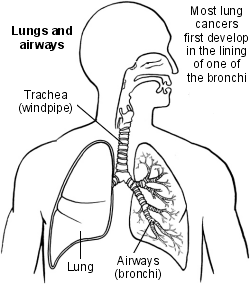
There are two lungs, one on either side of the chest. Air goes in to the lungs via the windpipe (trachea) which divides into a series of branching airways called bronchi. Air goes from the airways into millions of tiny air sacs (alveoli).
Oxygen from the air is passed into the bloodstream through the thin walls of the alveoli.
What is cancer?
Cancer is a disease of the cells in the body. The body is made up from millions of tiny cells. There are many different types of cell in the body, and there are many different types of cancer which arise from different types of cell. What all types of cancer have in common is that the cancer cells are abnormal and multiply 'out of control'.
A malignant tumour is a 'lump' or 'growth' of tissue made up from cancer cells which continue to multiply. Malignant tumours invade into nearby tissues and organs which can cause damage. Malignant tumours may also spread to other parts of the body. This happens if some cells break off from the first (primary) tumour and are carried in the bloodstream or lymph channels to other parts of the body. These small groups of cells may then multiply to form 'secondary' tumours (metastases) in one or more parts of the body. These secondary tumours may then grow, invade and damage nearby tissues, and spread again.
Some cancers are more serious than others, some are more easily treated than others (particularly if diagnosed at an early stage), some have a better outlook (prognosis) than others.
So, cancer is not just one condition. In each case it is important to know exactly what type of cancer has developed, how large it has become, and whether it has spread. This will enable you to get reliable information on treatment options and outlook.
See separate leaflet called 'What are Cancer and Tumours' for further details about cancer in general.
What is lung cancer?
Primary lung cancers
Primary lung cancers arise from cells in the lung. There are several types of primary lung cancer. The two most common types are called squamous cell carcinoma and small cell carcinoma. Lung cancers called adenocarcinoma and large cell carcinoma are less common. All four of these types of lung cancer arise from various cells which line the airways (bronchi). There are some other rarer types of primary lung cancer which arise from other types of cells in the lung.
Each type of lung cancer has different properties. For example, small cell carcinoma grows and spreads (metastasises) rapidly. By the time small cell cancer is diagnosed, in most cases it has already spread to other parts of the body. In contrast, a squamous cell carcinoma tends to grow more slowly and may not spread to other parts of the body for some time.
Primary lung cancer is one of the most common cancers in the UK. There are about 80,000 new cases diagnosed each year in the UK.
Secondary lung cancers
Secondary lung cancers (or lung metastases) are tumours which have spread to the lung from another cancer somewhere else in the body. The lung is a common site for metastases from other cancers. This is because all blood flows through the lungs and may contain tumour cells from any other part of the body. Secondary lung cancers are not dealt with further in this leaflet.
Mesothelioma
This is a cancer of the pleura, a lining tissue which covers the lungs. Strictly speaking, mesothelioma is not a lung cancer and is dealt with in a separate leaflet.
What causes lung cancer?
A cancerous tumour starts from one abnormal cell. It is thought that something damages or alters certain genes in the cell. This makes the cell abnormal and multiply 'out of control'. Certain risk factors increase the chance of certain cancers forming. (See separate leaflet called 'What Causes Cancer' for more details.)
Smoking
Smoking is a major risk factor and is the main cause of lung cancer. Chemicals in tobacco smoke are carcinogens - substances which can damage cells. About 9 in 10 cases of lung cancer are caused by smoking. About 1 in 7 long-term smokers develop lung cancer. Lung cancer most commonly develops in people between the age of 45 and 70 who have smoked since they were young adults.
Other factors
Non smokers have a low risk of developing lung cancer. However, people who are regularly exposed to other peoples smoke (passive smokers) have a small increased risk. People who work with certain substances such as radioactive materials, asbestos, nickel and chromium have an increased risk, especially if they also smoke. People who live in areas where there is a high level of background radiation from radon have a small increased risk. Air pollution may be a small risk too.
What are the symptoms of lung cancer?
Initial symptoms of lung cancer include:
As the cancer grows in the lung, the symptoms may become worse and may include:
If the cancer spreads to other parts of the body, various other symptoms can develop.